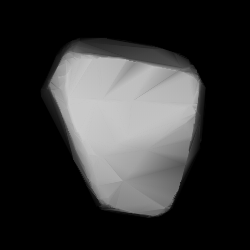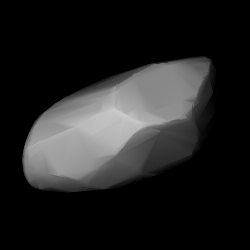
825 Tanina is a stony background asteroid from the region of the Flora family, located in the inner part of the asteroid belt. It was discovered on 27 March 1916, by Russian astronomer Grigory Neujmin at the Simeiz Observatory on Crimea. The elongated S-type asteroid (SR) has a rotation period of 6.9 hours and measures approximately 13 kilometers in diameter. Any reference of the asteroid's name to a person is unknown.
826 Henrika is a background asteroid from the central regions of the asteroid belt. It was discovered by German astronomer Max Wolf at the Heidelberg-Königstuhl State Observatory on 28 April 1916. The carbonaceous C-type asteroid has a rotation period of 5.98 hours and measures approximately 21 kilometers in diameter. Any reference to the origin of the asteroid's name is unknown.

834 Burnhamia is a large background asteroid, approximately 61 kilometers in diameter, that is located in the outer region of the asteroid belt. It was discovered on 20 September 1916, by German astronomer Max Wolf at the Heidelberg Observatory in southwest Germany. The X-type asteroid (GS) has a rotation period of 13.9 hours. It was named after American astronomer Sherburne Wesley Burnham (1838–1921).
835 Olivia is a dark background asteroid from the outer regions of the asteroid belt. It was discovered by German astronomer Max Wolf at the Heidelberg-Königstuhl State Observatory on 23 September 1916. The carbonaceous C-type asteroid measures approximately 35 kilometers in diameter, and is one of few low-numbered asteroids with an undetermined rotation period. Any reference to the origin of the asteroid's name is unknown.

842 Kerstin is a dark background asteroid from the outer regions of the asteroid belt. It was discovered on 1 October 1916, by German astronomer Max Wolf at the Heidelberg-Königstuhl State Observatory in southwest Germany. The assumed C-type asteroid has a rotation period of 18.7 hours and measures approximately 41 kilometers in diameter. Any reference of the origin of the asteroid's name is unknown.

856 Backlunda is a dark background asteroid from the inner region of the asteroid belt. It was discovered on 3 April 1916, by Russian astronomer Sergey Belyavsky at the Simeiz Observatory on the Crimean peninsula. The carbonaceous C-type asteroid has a rotation period of 12.1 hours and measures approximately 45 kilometers in diameter. It was named after Swedish-Russian astronomer Oskar Backlund (1846–1916).

979 Ilsewa is a background asteroid from the outer regions of the asteroid belt, approximately 36 kilometers in diameter. It was discovered by German astronomer Karl Reinmuth at the Heidelberg-Königstuhl State Observatory on 29 June 1922. The uncommon T-type asteroid has a longer-than average rotation period of 42.6 hours. It was named after Ilse Walldorf, an acquaintance of the discoverer.
Lagrangea, provisional designation 1923 OU, is a carbonaceous background asteroid from the outer region of the asteroid belt, approximately 30 kilometers in diameter. It was discovered on 12 September 1923, by Russian astronomer Sergey Belyavsky at the Simeiz Observatory on the Crimean peninsula. The asteroid was named after Italian mathematician and astronomer Joseph-Louis Lagrange.
1027 Aesculapia, provisional designation A923 YO11, is a Themistian asteroid from the outer region of the asteroid belt, approximately 33 kilometers in diameter.

1032 Pafuri, provisional designation 1924 SA, is a dark background asteroid from the outer regions of the asteroid belt, approximately 65 kilometers in diameter. It was discovered on 30 May 1924, by English astronomer Harry Edwin Wood at the Union Observatory in Johannesburg, South Africa. The asteroid was named for the river in the Pafuri Triangle in South Africa, created by the confluence of the Limpopo and Levubu rivers. The body's spectral type and rotation period are still poorly determined.
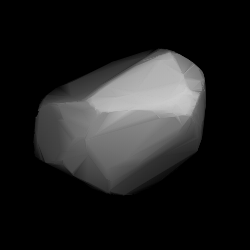
1088 Mitaka is a bright background asteroid from the inner regions of the asteroid belt. It was discovered on 17 November 1927, by Japanese astronomer Okuro Oikawa at the old Tokyo Astronomical Observatory in Japan. The stony S-type asteroid has a notably short rotation period of 3.0 hours and measures approximately 15 kilometers in diameter. It was named after the Japanese village of Mitaka.
2531 Cambridge, provisional designation 1980 LD, is a stony Eoan asteroid from the outer regions of the asteroid belt, approximately 20 kilometers in diameter. It was discovered on 11 June 1980, by American astronomer Edward Bowell at Lowell's Anderson Mesa Station in Arizona, United States. The asteroid was named for the "centers of learning in England and in Massachusetts".
3037 Alku, provisional designation 1944 BA, is a carbonaceous asteroid from the central region of the asteroid belt, approximately 20 kilometers in diameter. It was discovered on 17 January 1944, by Finnish astronomer Yrjö Väisälä at Turku Observatory in Southwest Finland.
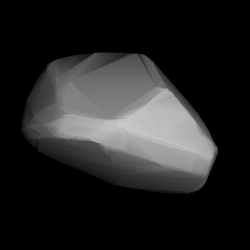
3544 Borodino (prov. designation: 1977 RD4) is a stony background asteroid from the inner regions of the asteroid belt, approximately 9 kilometers (5.6 miles) in diameter. It was discovered on 7 September 1977, by Soviet astronomer Nikolai Chernykh at the Crimean Astrophysical Observatory in Nauchnij, on the Crimean peninsula. The likely elongated S-type asteroid has a rotation period of 5.44 hours. It was named for the Russian village of Borodino where the Battle of Borodino took place.
1541 Estonia, provisional designation 1939 CK, is an asteroid from the central regions of the asteroid belt, approximately 21 kilometers in diameter. It was discovered on 12 February 1939, by astronomer Yrjö Väisälä at the Iso-Heikkilä Observatory near Turku, Finland. The asteroid was named after the Baltic country of Estonia.
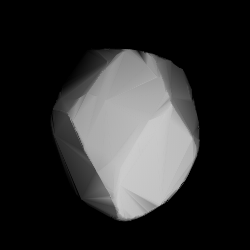
1281 Jeanne is a dark asteroid from the background population of the intermediate asteroid belt. It was discovered on 25 August 1933, by astronomer Sylvain Arend at the Royal Observatory of Belgium in Uccle, who named it after his daughter, Jeanne. The likely P-type asteroid has a rotation period of 15.2 hours and measures approximately 22 kilometers in diameter.

1175 Margo, provisional designation 1930 UD, is a stony background asteroid from the outermost regions of the asteroid belt, approximately 24 kilometers in diameter. It was discovered on 17 October 1930, by astronomer Karl Reinmuth at the Heidelberg-Königstuhl State Observatory in southwest Germany. The meaning of the asteroids's name is unknown.

1366 Piccolo, provisional designation 1932 WA, is an asteroid from the background population of the outer asteroid belt, approximately 28 kilometers in diameter. It was discovered on 29 November 1932, by astronomer Eugène Delporte at the Royal Observatory of Belgium in Uccle. The asteroid was named after Auguste Cauvin, chief-editor of the Belgian newspaper Le Soir.
1847 Stobbe, provisional designation A916 CA, is an asteroid from the middle region of the asteroid belt, approximately 23 kilometers in diameter.
1535 Päijänne, provisional designation 1939 RC, is an asteroid from the outer region of the asteroid belt, approximately 25 kilometers in diameter. It was discovered on 9 September 1939, by Finnish astronomer Yrjö Väisälä at the Turku Observatory in Southwest Finland. It was later named for Lake Päijänne.
